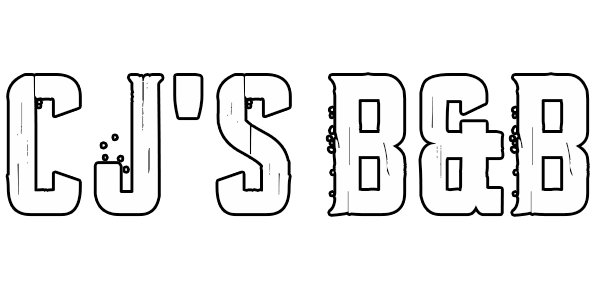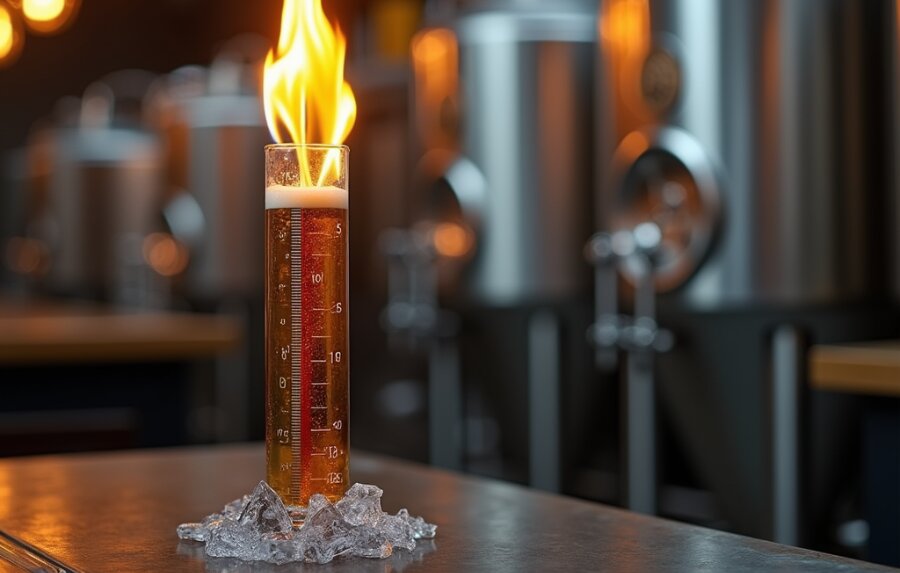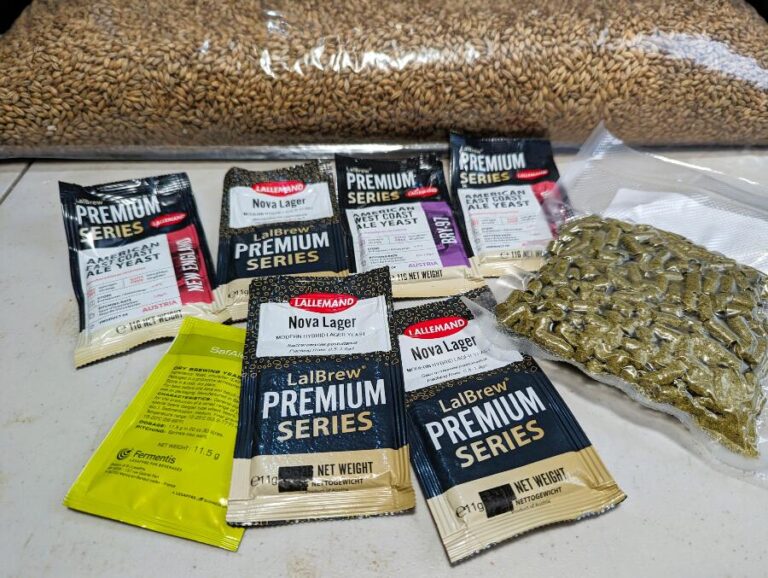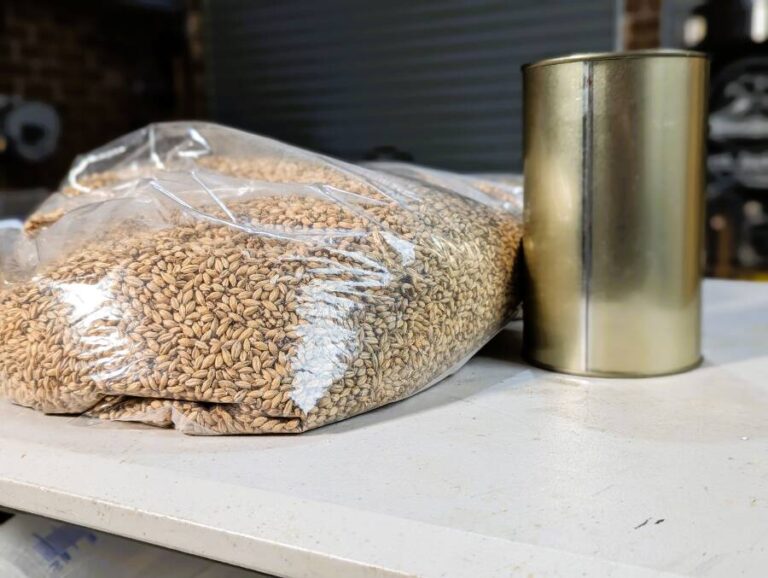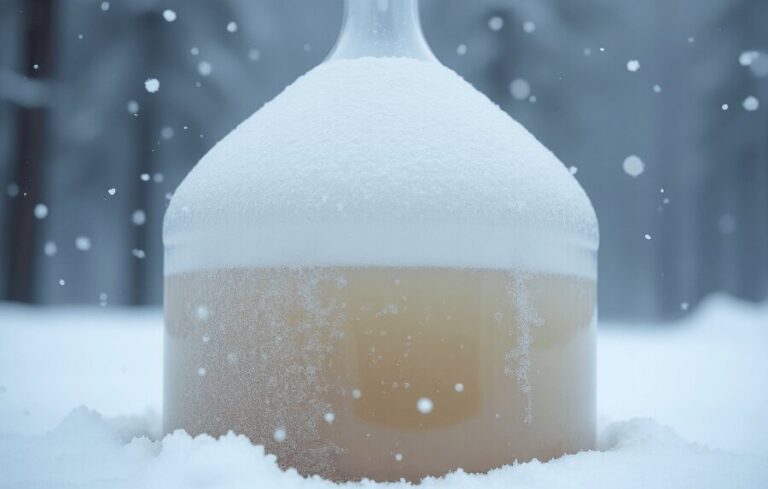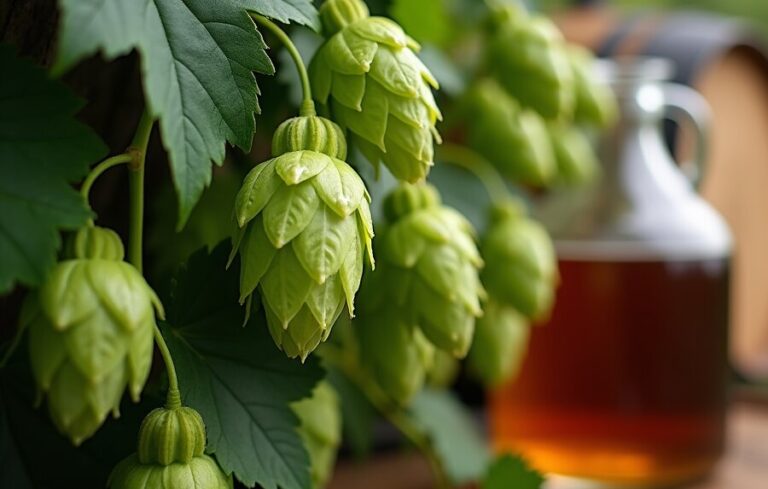Our evaluations and product assessments are conducted using a thorough and unbiased approach. Should you choose to buy any items through our provided links, we might receive a commission Read our disclosures.
Understanding Fermentation Temperature
Fermentation temperature ain’t just some random number you dial in. It’s got a massive impact on your homebrew’s taste, smell, and overall quality. Understanding Homebrew Fermentation Temperature Management is key. Let’s break it down in a way that won’t put you to sleep.
How Temperature Messes with Flavor and Aroma
Getting the temperature right during fermentation is essential. Each yeast strain has its sweet spot, producing tasty flavors and inviting aromas. Keep it in that range, and you’re golden. Let it stray, and you’re looking at some funky off-flavors.
Take Pilsner, for instance. They thrive between 45-55°F, giving you that clean, crisp flavor (Tar Barrel). Here’s a cheat sheet for how temperatures can mess with your beer’s mojo:
By mastering Homebrew Fermentation Temperature Management, you can enhance the complexity and richness of your brews.
| Temperature Range (°F) | Common Effects |
|---|---|
| 50-55 | Smooth, clean lagers with balanced taste |
| 60-70 | Fruity and spicy notes typical in ales |
| 75+ | Weirdly fruity or straight-up bad flavors, even some astringency |
Yeast Strains and What They Like
Ever want to be a yeast whisperer? Well, each strain of yeast has a preferred temperature that makes it happy and productive. As a homebrewer, knowing these temperature preferences and applying Homebrew Fermentation Temperature Management is your ticket to brewing bliss.
Lager yeast loves the chill – think 45-55°F. Too cold, though, and they’ll go dormant. Ale yeast prefers things a bit warmer, around 60-75°F. Then there’s kveik yeast, which actually thrives when it’s hot, leading to some wild tropical flavors.
Here’s a quick rundown:
| Yeast Strain | Optimal Temperature Range (°F) | Flavor Profiles |
|---|---|---|
| Lager Yeast | 45-55 | Crisp and clean |
| Ale Yeast | 60-75 | Fruity with some spice |
| Kveik Yeast | 70-100 | Exotic tropical vibes |
Knowing these specifics can turn you into a homebrew hero. Keep an eye on that thermometer, and don’t be afraid to tweak things to get the flavor you’re aiming for. Curious about the nitty-gritty of controlling fermenting temperatures? Check out homebrew fermentation temperature management and dive deeper into homebrew fermentation temperature fluctuations.
What’s The Deal with Fermentation Temperature?
Ever wondered why the temperature of your brew matters so much? Well, it’s all about getting the right flavors and making sure your beer turns out just like you imagined. Let’s break it down into two key points: enzymes doing their magic and knowing the sweet spot for temperatures.
Enzymatic Activity
You know those magical beings called enzymes? Yeah, they’re the little workhorses in your yeast that turn sugar into alcohol. But, the temperature can either turbocharge these guys or make them take a nap. Warm up your brew, and the enzymes go nuts, speeding up fermentation. Cool things down, and you’ve got a slow dance going on, especially with lagers. According to the American Homebrewers Association, the temperature directly messes with enzyme speed, making your job as a brewer all about fine-tuning the heat dial.
Here’s your cheat sheet:
| Temperature Range (°F) | Enzymatic Activity Level | Fermentation Speed |
|---|---|---|
| 55-65 | Low | Slow |
| 66-70 | Moderate | Normal |
| 71-75 | High | Fast |
Keeping it Optimal
Each yeast strain has its own happy place when it comes to temperature. Get it right, and you’ll nail that perfect flavor and boozy goodness. Mess it up, and you might end up with something funky— and not in a good way. Different yeasts need different TLC:
| Yeast Strain | Optimal Temperature Range (°F) | Characteristics |
|---|---|---|
| Ale Yeast | 60-75 | Fruity, quick to ferment |
| Lager Yeast | 45-55 | Clean, crisp, takes its time |
| Belgian Yeast | 65-75 | Complex, fruity, spicy |
When the weather outside is frightful, especially for lagers, yeast cells can get lazy and drop out of suspension, messing with your brew Atlas Scientific. So, if you’re dreaming of that perfect pint, pay attention to your fermentation setup. Control the temps, and you control the flavor.
Want to get geekier about it? Dive into guides on homebrew fermentation temperature range and homebrew fermentation temperature fluctuations.

Keeping Your Brew Chill: Mastering Fermentation Temperature
Getting a handle on the fermentation temperature is the secret sauce for homebrewers. Control it right, and you’ll not only nail the flavors and aromas but also get that high-five-worthy quality in your beer.
Why Bother?
The magic happens when you control the temperature. Go a little rogue and your yeast might throw a fit—altering the taste and aroma in ways you didn’t sign up for. Heat things up too much, and you’re looking at a fruity, spicy mess, thanks to esters and phenols that weren’t on the guest list.
Check out this cheat sheet:
| Yeast Type | Happy Temp Range (°F) | What Happens if You Mess Up |
|---|---|---|
| Ale Yeast | 65 – 75 | Think fruity—like beer sangria |
| Lager Yeast | 45 – 55 | Clean, crisp, and straight to the point |
| Belgian Yeast | 70 – 80 | Spicy and fruity bonanza |
Cool Hacks to Keep Your Brew Happy
You don’t need to raid your savings for fancy equipment. Here are some MacGyver-approved tricks:
- Wet Towel Magic: Wrap your fermenter in a damp towel. As the water evaporates, it keeps things cool.
- Ice Pack Maneuver: Surround your fermenter with ice packs or stash it in a cooler for a chill zone.
- Homemade Fermentation Chamber: Got a cool basement? Set up your fermenter down there for a consistent environment.
If you’re feeling extra fancy, step up your game with a dedicated fermentation chamber or temperature-controlled fermenters. Want to go pro? Try immersion chillers or high-tech cooling to keep those temps steady.
By using these DIY hacks, you can boss the fermentation temperature game, giving your brew that extra polish. Know your yeast and what temperatures they dig, and you’re halfway to brew-master fame. For more geeky details, check out homebrew fermentation temperature range and learn why homebrew fermentation temperature fluctuations matter. Happy brewing!
Yeast Varieties and Temperature Tolerance
Different types of yeast act differently and handle various temperatures during fermentation. Knowing these differences is key for nailing homebrew fermentation.
Brewer’s Yeast Behavior
Brewer’s yeast, or Saccharomyces cerevisiae if you’re fancy, likes it warm—somewhere between 80-90°F (27-32°C). But here’s the catch: fermenting at those temps can make your beer taste funny with off-flavors like esters and fusels. (American Homebrewers Association).
Check out how temperature affects brewer’s yeast:
| Temperature (°F) | Yeast Mood | Flavor Vibes |
|---|---|---|
| 70-75 | Goldilocks zone | Clean, balanced taste |
| 75-80 | More action-packed | Lightly fruity, but watch out |
| 80-90 | Full throttle | Strong esters & fusels; not great |
Keep it cooler to make sure your beer tastes crisp and refreshing. Homebrewers should always keep an eye on the temp to ensure top-notch beer.
Kveik Yeast Characteristics
Kveik yeast, hailing from Norway, is a beast. It can handle extreme temperatures, often above 90°F (32°C), without giving you those pesky off-flavors. Generations of Norwegian brewers selected and reused the best Kveik strains, making it truly special.
Here’s how Kveik yeast performs:
| Temperature (°F) | Yeast Behavior | Flavor Notes |
|---|---|---|
| 90+ | Turbocharged | Clean, neutral flavors |
| 85-90 | Sugar savant | Light fruitiness, no bad aftertaste |
| 75-85 | Slower but steady | Complex and balanced |
Using Kveik yeast, you can speed up the brewing process while keeping your beer tasting great. Perfect for those who want to play with high-temperature brewing.
Knowing how different yeast strains work helps homebrewers dial in the best fermentation temperatures. Whether you’re using brewer’s yeast or Kveik, temperature control is the secret to delicious beer. For more tips on keeping your brew steady, check out our guide on homebrew fermentation temperature fluctuations.
Keep Your Cool: Practical Tips for Temperature Control
Alright folks, let’s talk about the secret sauce to great homebrew: nailing that fermentation temperature. Get this right, and you’re well on your way to brewing beer that makes others say, “Whoa, you made this?” Here’s the lowdown on how to keep your brew just right.
Gear Up Right
First off, let’s chat about gear. Having the right tools can save you from a brew disaster. For precision lovers, temperature controllers are your new best friend. These nifty gadgets keep your fermenters exactly where they need to be, temperature-wise.
| Gadget | Why You Need It |
|---|---|
| Temperature Controller | Keeps things steady, no wild swings here. |
| Fermentation Chamber | Think of it as a cozy, stable home for your brew. |
| Immersion Chiller | Cool your wort fast, avoid those nasty temperature spikes. |
| DIY Coolers | Budget-friendly hacks that still get the job done. |
Even if you’re not splurging on fancy gear, setting up a dedicated fermentation area or rigging up some DIY coolers can do wonders for your brew.
Consistency is King
Let’s face it, yeast are picky little things. They like their temp just right. Brew outside their comfort zone and you’re introducing potential funk—and not the good kind. Most brewer’s yeast likes it between 80-90? (27-32?) but push too high and you could end up with off-flavors. Yuck.
Here’s how to keep it steady:
- Fermentation Chambers: These bad boys isolate your brew from the wonky stuff going on outside—like that hot afternoon sun.
- Temp-Controlled Fermenters: Adjust the settings and let technology keep things ideal.
- Regular Monitoring: Keep a close eye on the temps, catch any weird swings early.
- Stay Cool: Don’t let your gear sit in direct sunlight or near heaters. That’s just asking for trouble.
Struggling with temp swings? No worries, just get clued up on managing homebrew temperature fluctuations and you’ll be fine.
Invest in good gear and keep things consistent, and you’ll see a noticeable bump in your beer quality and flavor. And if you’re curious about getting into the nitty-gritty like cold crashing your brew, there are plenty of resources to step up your game.
Remember, folks, keep it cool and your brew will thank you. Cheers!
The Big Impact of Fermentation Temperature on Your Homebrew
Figuring out how fermentation temperature shapes your brewing is a game-changer for any homebrewer. There are two main parts you need to nail: mashing and conditioning.
The Mashing Magic
Getting the temperature right during mashing is like setting the stage for your entire beer party. The temperature you land on controls what kind of sugars you pull from the malted grains, which in turn, dictates your beer’s taste.
| Mashing Temperature (°F) | Sugar Profile | Beer Style |
|---|---|---|
| 148 – 152 | Dryer, less body | Pale Ales, IPAs |
| 154 – 158 | Fuller, sweeter | Stouts, Porters |
| 160+ | Sweet, high body | Barleywines |
Mashing at lower temperatures gives you a dry beer, while higher temperatures make it sweeter and fuller. This step needs your attention like a hawk, because it sets up the flavors and textures that’ll come out later in fermentation.
As a homebrewer, having a good grip on temp control during mashing, or knowing how to tweak your setup, can really push your beer to the next level.
Conditioning the Brew
After fermentation, next up is conditioning. This is where your flavors get to shine and deepen. Keeping an eye on the temperature here helps smooth out any rough flavors and lets good ones develop (Specific Mechanical Systems).
| Conditioning Temperature (°F) | Flavor Effect |
|---|---|
| 32 – 36 | Clearer, refined flavors |
| 40 – 50 | Complex flavors develop |
| 60+ | Risk of off-flavors |
Keeping a steady temperature during conditioning is key. It’s one of those little steps that makes a big difference in clarity and taste.
So, nailing your mashing and conditioning temps can really take your homebrew from “meh” to “wow.” It’s all about getting those flavors just right and making sure your beer’s as clear and tasty as you’ve dreamed. Happy brewing!

